
Hover flies, also called flower flies or syrphid flies, make up the insect family Syrphidae. As their common name suggests, they are often seen hovering or nectaring at flowers; the adults of many species feed mainly on nectar and pollen, while the larvae (maggots) eat a wide range of foods. In some species, the larvae are saprotrophs, eating decaying plant and animal matter in the soil or in ponds and streams. In other species, the larvae are insectivores and prey on aphids, thrips, and other plant-sucking insects.

Sericomyia chrysotoxoides ,, the Oblique-banded Pond Fly , is a common species of syrphid fly observed across the eastern half of North America and in the Rocky Mountains. Syrphid flies are also known as Hover Flies or Flower Flies because the adults are frequently found hovering around flowers from which they feed on nectar and pollen. Adults are 9.6–1,315.3 mm (0.38–51.78 in) long, black with yellow bands, less prominent in the male. The larvae of this genus are known as rat tailed maggots for the long posterior breathing tube.

Sericomyia militaria, commonly known as the narrow-banded pond fly, is a common species of syrphid fly observed across northern North America. Syrphid flies are also known as Hover Flies or Flower Flies because the adults are frequently found hovering around flowers from which they feed on nectar and pollen. Adults are 11.7–17.1 mm (0.46–0.67 in) long, mostly black with narrow yellow abdominal markings. The larvae of this genus are known as rat tailed maggots for the long posterior breathing tube.

Teuchocnemis lituratus ,, the The Black Spur Fly , is an uncommon species of syrphid fly observed in the eastern half of North America. Syrphid flies are also known as Hover Flies or Flower Flies because the adults are frequently found hovering around flowers from which they feed on nectar and pollen. Adults are 10.5–15.4 mm (0.41–0.61 in)long, black with a yellow scutellum and hind tibia of male with spike. The larvae are unknown.

Sericomyia lata , the White-spotted Pond Fly , is a common species of syrphid fly observed across North America, concentrated in the east. Syrphid flies are also known as Hover Flies or Flower Flies because the adults are frequently found hovering around flowers from which they feed on nectar and pollen. Adults are 11.6–15.2 mm (0.46–0.60 in) long and black with large white abdominal spots. The larvae of this genus are known as rat tailed maggots for the long posterior breathing tube.
Xylota quadrimaculata ,, the Four-spotted Leafwalker , is a common species of syrphid fly observed in central and eastern North America. Syrphid flies are also known as Hover Flies or Flower Flies because the adults are frequently found hovering around flowers from which they feed on nectar and pollen. Adults are 8.2–11.3 mm (0.32–0.44 in) long, black with yellow-orange spots on the abdomen. The larvae of this genus live under bark in sap runs.

Syrphus knabi, the The Eastern flower Fly, is an uncommon species of syrphid fly observed in the eastern United States and Canada. Syrphid flies are also known as Hover Flies or Flower Flies because the adults are frequently found hovering around flowers from which they feed on nectar and pollen. Adults are 7.2–12.9 mm (0.28–0.51 in) long. The larvae are predators of a variety of aphids in trees.
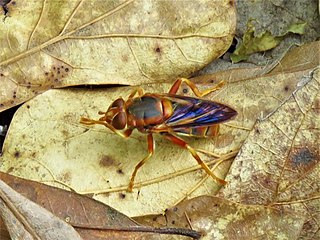
Teuchocnemis bacuntius ,, the Orange Spur Fly , is a rare species of syrphid fly observed in eastern half of the United States. Syrphid flies are also known as Hover Flies or Flower Flies because the adults are frequently found hovering around flowers from which they feed on nectar and pollen. Adults are 13.5–18.1 mm (0.53–0.71 in) long, orange with a swolen hind femur and the hind tibia of the male with a ventral spur. The larvae are unknown.
Anasimyia grisescens ,, the Long-spurred Swamp Fly , is a rare species of syrphid fly observed on the Atlantic coast of the United States. Syrphid flies are also known as Hover Flies or Flower Flies because the adults are frequently found hovering around flowers from which they feed on nectar and pollen. They are 7.2–10.1 mm (0.28–0.40 in) long. The larvae are unknown.

Chalcosyrphus depressus the Wide-eyed Leafwalker, is a rare species of syrphid fly observed from Idaho and Montana. Hoverflies can remain nearly motionless in flight. The adults are also known as flower flies for they are commonly found on flowers, from which they get both energy-giving nectar and protein-rich pollen.
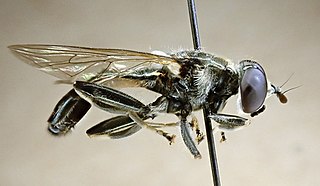
Xylota angustiventris,, the Two-spotted Leafwalker , is an uncommon species of syrphid fly observed in northeast North America. Syrphid flies are also known as Hover Flies or Flower Flies because the adults are frequently found hovering around flowers from which they feed on nectar and pollen. Adults are 12.2–14.4 mm (0.48–0.57 in) long, largely black with two yellow spots on the abdomen in the male? The larvae are not known, but in this genus, are likely to be found in tree holes or bark to feed on sap.
Xylota subfasciata ,, the Large-spotted Forest Fly , is an uncommon species of syrphid fly observed widely across North America. Syrphid flies are also known as Hover Flies or Flower Flies because the adults are frequently found hovering around flowers from which they feed on nectar and pollen. Adults are 8.7–1,312.5 mm (0.34–51.67 in) long, black with large yellow abdominal spots. The larvae of this genus live under bark in sap runs.
Xylota annulifera ,, the Longspine Leafwalker , is an uncommon species of syrphid fly observed across Canada and in the eastern United States. Syrphid flies are also known as Hover Flies or Flower Flies because the adults are frequently found hovering around flowers from which they feed on nectar and pollen. Adults are 7.5–11.8 mm (0.30–0.46 in) long, black with yellow abdominal spots. The larvae of this genus live under bark in sap runs.
Xylota confusa ,, the Confusing Leafwalker , is an uncommon species of syrphid fly observed across Northern North America. Syrphid flies are also known as Hover Flies or Flower Flies because the adults are frequently found hovering around flowers from which they feed on nectar and pollen. Adults are 9.3–12.6 mm (0.37–0.50 in) long. The larvae of this genus live under bark in sap runs.
Xylota naknek , the Naknek Leafwalker , is a fairly common species of syrphid fly observed across Canada and the Northeastern United States. Syrphid flies are also known as Hover Flies or Flower Flies because the adults are frequently found hovering around flowers from which they feed on nectar and pollen. Adults are 9.1–12.8 mm (0.36–0.50 in) long. The larvae of this genus live under bark in sap runs.
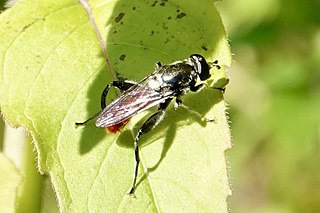
Xylota bicolor ,, the Eastern Orange-tailed Leafwalker , is a rare species of syrphid fly observed across the eastern half of North America. Syrphid flies are also known as Hover Flies or Flower Flies because the adults are frequently found hovering around flowers from which they feed on nectar and pollen. Adults are 13.8–14.7 mm (0.54–0.58 in) in length, black with an orange abdomen The larvae of this genus live under bark in sap runs.
Xylota ejuncida ,, the Polished Leafwalker , is a rare species of syrphid fly observed in the eastern North America. Syrphid flies are also known as Hover Flies or Flower Flies because the adults are frequently found hovering around flowers from which they feed on nectar and pollen. Adults are 9.6–10.9 mm (0.38–0.43 in) long. The larvae of this genus live under bark in sap runs.
Xylota flavifrons ,, the Northern Leafwalker , is an uncommon species of syrphid fly observed in the northeastern United States and all across Canada. Syrphid flies are also known as Hover Flies or Flower Flies because the adults are frequently found hovering around flowers from which they feed on nectar and pollen. Adults are 9.4–14.7 mm (0.37–0.58 in) long. The larvae of this genus live under bark in sap runs.
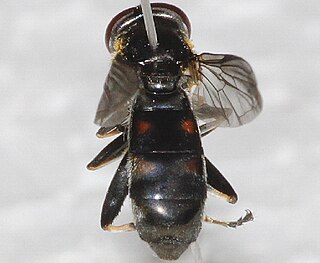
Xylota hinei , ( ), the Hine's Leafwalker , is an uncommon species of syrphid fly observed in Eastern Canada. Syrphid flies are also known as Hover Flies or Flower Flies because the adults are frequently found hovering around flowers from which they feed on nectar and pollen. Adults are 7.8–12.9 mm (0.31–0.51 in) long, black with yellow spots. The larvae of this genus live under bark in sap runs.
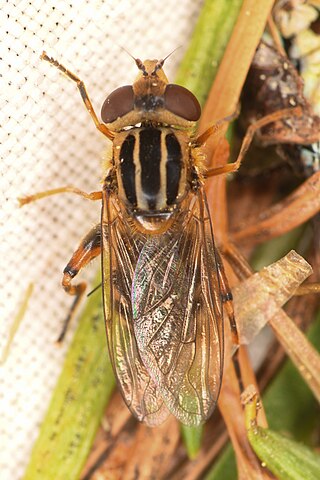
Eurimyia stipata, the long-nosed swamp fly, is a very common species of syrphid fly observed across northern North America. Syrphid flies are also known as Hover Flies or Flower Flies because the adults are frequently found hovering around flowers from which they feed on nectar and pollen. Adults are 11.7–17.1 mm (0.46–0.67 in) long with a striped scutum and sawtooth yellow abdominal spots. Larvae of this genus are aquatic.











